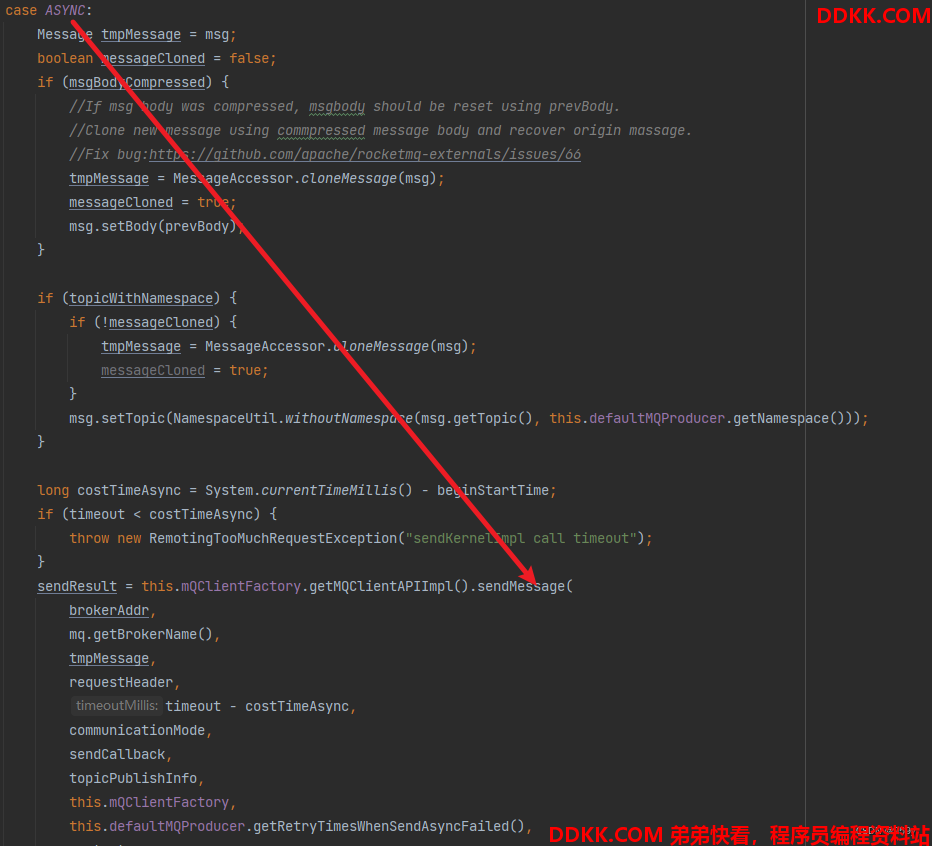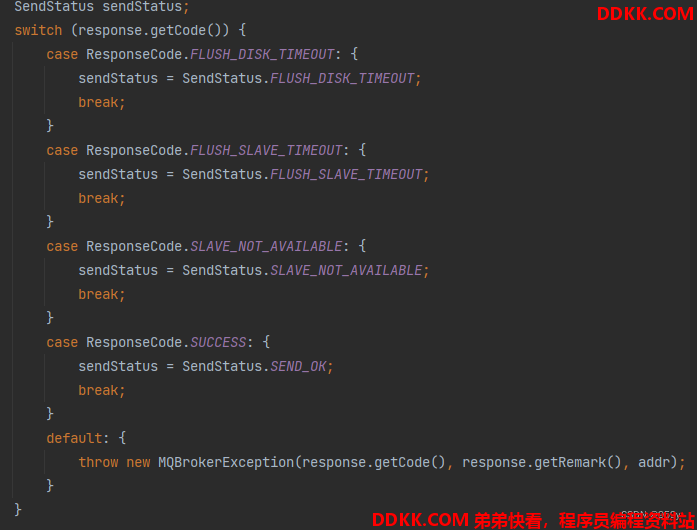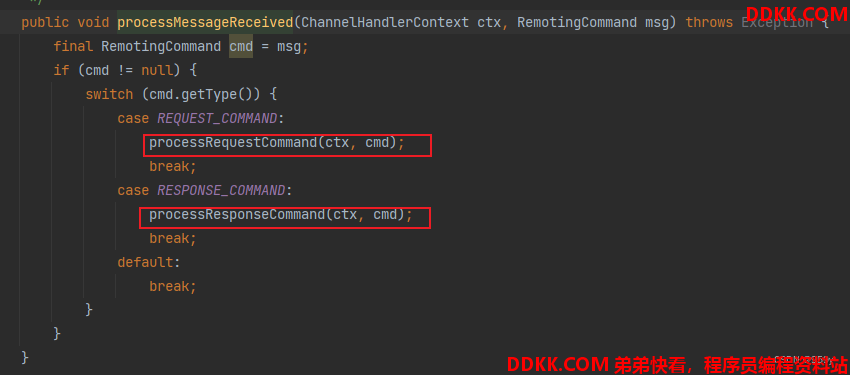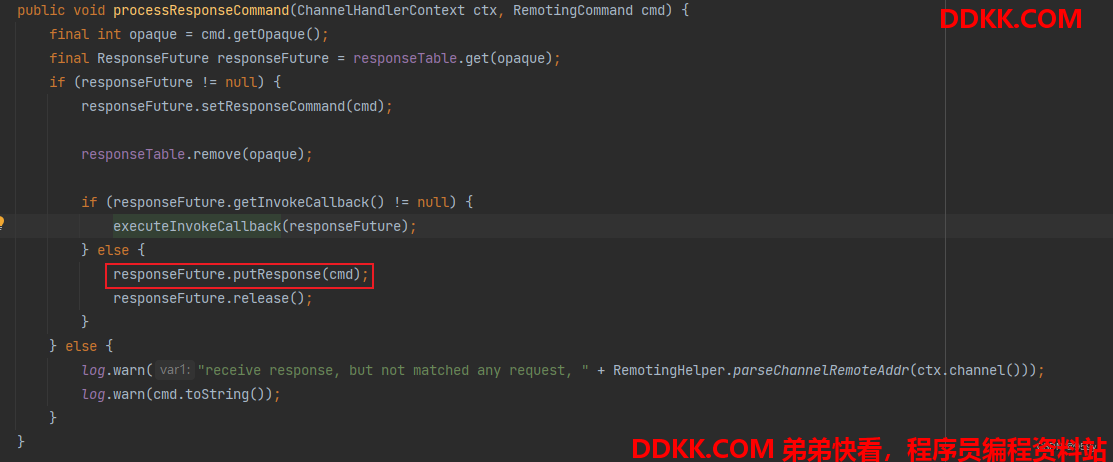1.sendMessage方法发送消息
DefaultMQProducerImpl#sendKernelImpl() -> MQClientAPIImpl#sendMessage()


MQClientAPIImpl#sendMessage : 异步、单向、同步发送模式都会调用MQClientAPIImpl#sendMessage方法发送消息。
1、 首先构建发送消息命令对象RemotingCommand,此时会判断是否需要更换轻量级消息头,如果sendSmartMsg属性为true或者为批量消息的话,则使用轻量头;
2. 根据发送模式执行不同的发送逻辑, 单向发送模式调用NettyRemotingClient#invokeOneway, 异步发送调用MQClientAPIImpl#sendMessageAsync, 同步发送调用MQClientAPIImpl#sendMessageSync。
/**
* MQClientAPIImpl的方法
* 同步、异步、单向消息的最终发送消息的方法
*
* @param addr brokerAddr
* @param brokerName brokerName
* @param msg msg
* @param requestHeader requestHeader
* @param timeoutMillis 剩余超时时间
* @param communicationMode 发送模式
* @param sendCallback 发送回调函数
* @param topicPublishInfo topic信息
* @param instance MQClientInstance
* @param retryTimesWhenSendFailed 异步发送失败时的重试次数,默认2
* @param context 发送消息上下文
* @param producer DefaultMQProducerImpl
* @return
* @throws RemotingException
* @throws MQBrokerException
* @throws InterruptedException
*/
public SendResult sendMessage(
final String addr,
final String brokerName,
final Message msg,
final SendMessageRequestHeader requestHeader,
final long timeoutMillis,
final CommunicationMode communicationMode,
final SendCallback sendCallback,
final TopicPublishInfo topicPublishInfo,
final MQClientInstance instance,
final int retryTimesWhenSendFailed,
final SendMessageContext context,
final DefaultMQProducerImpl producer
) throws RemotingException, MQBrokerException, InterruptedException {
long beginStartTime = System.currentTimeMillis();
RemotingCommand request = null;
//消息类型
String msgType = msg.getProperty(MessageConst.PROPERTY_MESSAGE_TYPE);
//是否时重试消息
boolean isReply = msgType != null && msgType.equals(MixAll.REPLY_MESSAGE_FLAG);
/*
* 1 构建发送消息命令对象RemotingCommand,更换轻量级消息头
*
* sendSmartMsg表示是否使用更轻量级的消息头SendMessageRequestHeaderV2
* 相比于requestHeader,其field 全为 a,b,c,d 等短变量名,可以加快FastJson反序列化过程。
*/
if (isReply) {
//sendSmartMsg默认为true
if (sendSmartMsg) {
//构建轻量级消息头
SendMessageRequestHeaderV2 requestHeaderV2 = SendMessageRequestHeaderV2.createSendMessageRequestHeaderV2(requestHeader);
//创建发送消息命令对象,RequestCode为SEND_REPLY_MESSAGE_V2
request = RemotingCommand.createRequestCommand(RequestCode.SEND_REPLY_MESSAGE_V2, requestHeaderV2);
} else {
//创建发送消息命令对象,RequestCode为SEND_REPLY_MESSAGE
request = RemotingCommand.createRequestCommand(RequestCode.SEND_REPLY_MESSAGE, requestHeader);
}
} else {
if (sendSmartMsg || msg instanceof MessageBatch) {
//构建轻量级消息头
SendMessageRequestHeaderV2 requestHeaderV2 = SendMessageRequestHeaderV2.createSendMessageRequestHeaderV2(requestHeader);
//如果是批量消息,则RequestCode为SEND_BATCH_MESSAGE,否则RequestCode为SEND_MESSAGE_V2
request = RemotingCommand.createRequestCommand(msg instanceof MessageBatch ? RequestCode.SEND_BATCH_MESSAGE : RequestCode.SEND_MESSAGE_V2, requestHeaderV2);
} else {
//创建发送消息命令对象,RequestCode为SEND_MESSAGE
request = RemotingCommand.createRequestCommand(RequestCode.SEND_MESSAGE, requestHeader);
}
}
//设置body
request.setBody(msg.getBody());
/*
* 2 根据发送模式执行不同的发送逻辑
*/
switch (communicationMode) {
case ONEWAY:
/*
* 单向发送,调用该方法之后不接收返回值,直接返回null
*/
this.remotingClient.invokeOneway(addr, request, timeoutMillis);
return null;
case ASYNC:
//异步消息重试计数器
final AtomicInteger times = new AtomicInteger();
//计算是否超时,如果超时则不再发送
long costTimeAsync = System.currentTimeMillis() - beginStartTime;
if (timeoutMillis < costTimeAsync) {
throw new RemotingTooMuchRequestException("sendMessage call timeout");
}
/*
* 异步发送,调用该方法之后不接收返回值,直接返回null
*/
this.sendMessageAsync(addr, brokerName, msg, timeoutMillis - costTimeAsync, request, sendCallback, topicPublishInfo, instance,
retryTimesWhenSendFailed, times, context, producer);
return null;
case SYNC:
//计算是否超时,如果超时则不再发送
long costTimeSync = System.currentTimeMillis() - beginStartTime;
if (timeoutMillis < costTimeSync) {
throw new RemotingTooMuchRequestException("sendMessage call timeout");
}
/*
* 同步发送,调用该方法之后阻塞直至收到返回值
*/
return this.sendMessageSync(addr, brokerName, msg, timeoutMillis - costTimeSync, request);
default:
assert false;
break;
}
return null;
}

2.invokeOneway单向发送
消息只会发送一次, 且不会返回结果, 不管发送的结果。不会进行任何重试。
/**
* NettyRemotingClient的方法
* <p>
* 单向消息发送的通用方法
*
* @param addr 服务器地址
* @param request 请求命令对象
* @param timeoutMillis 超时时间
*/
@Override
public void invokeOneway(String addr, RemotingCommand request, long timeoutMillis) throws InterruptedException,
RemotingConnectException, RemotingTooMuchRequestException, RemotingTimeoutException, RemotingSendRequestException {
//获取或者建立同服务器的通道,即连接
final Channel channel = this.getAndCreateChannel(addr);
if (channel != null && channel.isActive()) {
try {
//执行rpcHook的前置方法doBeforeRequest
doBeforeRpcHooks(addr, request);
/*
* 调用另一个invokeOnewayImpl方法,发送单向消息
*/
this.invokeOnewayImpl(channel, request, timeoutMillis);
} catch (RemotingSendRequestException e) {
log.warn("invokeOneway: send request exception, so close the channel[{}]", addr);
this.closeChannel(addr, channel);
throw e;
}
} else {
this.closeChannel(addr, channel);
throw new RemotingConnectException(addr);
}
}
1、 getAndCreateChannel方法获取或者建立同服务器的通道,如果没有获取到,则创建连接;
2、 执行rpcHook的前置方法doBeforeRequest;
3、 调用invokeOnewayImpl方法,实现单向发送消息;
2.1 invokeOnewayImpl单向调用

1、 首先将请求标记为单向发送;
2、 然后基于Semaphore信号量尝试获取单向发送的资源通过信号量控制单向消息并发发送的消息数,从而保护系统内存占用客户端单向发送的Semaphore信号量默认为65535,即单向发送的消息最大并发为65535;
3、 获取信号量资源后,构建SemaphoreReleaseOnlyOnce对象,保证信号量本次只释放一次,防止并发操作引起的线程安全问题,通过channel发送请求;
4、 在监听器ChannelFutureListener中,会释放信号量,如果发送失败了,打印warn日志如果没有获取到信号量资源,那么直接抛出异常并且不再发送;
/**
* NettyRemotingAbstract的方法
* <p>
* 单向消息发送的逻辑
*
* @param channel 通道
* @param request 请求
* @param timeoutMillis 超时时间
*/
public void invokeOnewayImpl(final Channel channel, final RemotingCommand request, final long timeoutMillis)
throws InterruptedException, RemotingTooMuchRequestException, RemotingTimeoutException, RemotingSendRequestException {
//标记为单向发送
request.markOnewayRPC();
//基于Semaphore信号量尝试获取单向发送的资源,通过信号量控制单向消息并发发送的消息数,从而保护系统内存占用。
//客户端单向发送的Semaphore信号量默认为65535,可通过配置"com.rocketmq.remoting.clientOnewaySemaphoreValue"系统变量更改
boolean acquired = this.semaphoreOneway.tryAcquire(timeoutMillis, TimeUnit.MILLISECONDS);
//如果获取到了信号量资源
if (acquired) {
//构建SemaphoreReleaseOnlyOnce对象,保证信号量本次只被释放一次,防止并发操作引起线程安全问题
final SemaphoreReleaseOnlyOnce once = new SemaphoreReleaseOnlyOnce(this.semaphoreOneway);
try {
//将请求发送出去即可
channel.writeAndFlush(request).addListener(new ChannelFutureListener() {
@Override
public void operationComplete(ChannelFuture f) throws Exception {
//释放信号量
once.release();
//如果发送失败了,仅仅是打印一行warn日志,然后就不管了,这就是单向发送
if (!f.isSuccess()) {
log.warn("send a request command to channel <" + channel.remoteAddress() + "> failed.");
}
}
});
} catch (Exception e) {
//释放信号量
once.release();
log.warn("write send a request command to channel <" + channel.remoteAddress() + "> failed.");
throw new RemotingSendRequestException(RemotingHelper.parseChannelRemoteAddr(channel), e);
}
} else {
//如果没有获取到信号量资源,那么直接抛出异常即可,并且不再发送
if (timeoutMillis <= 0) {
throw new RemotingTooMuchRequestException("invokeOnewayImpl invoke too fast");
} else {
String info = String.format(
"invokeOnewayImpl tryAcquire semaphore timeout, %dms, waiting thread nums: %d semaphoreOnewayValue: %d",
timeoutMillis,
this.semaphoreOneway.getQueueLength(),
this.semaphoreOneway.availablePermits()
);
log.warn(info);
throw new RemotingTimeoutException(info);
}
}
}
3.sendMessageSync同步发送
- 发送之后会同步阻塞直到结果返回。

/**
* MQClientAPIImpl的方法
*/
private SendResult sendMessageSync(
final String addr,
final String brokerName,
final Message msg,
final long timeoutMillis,
final RemotingCommand request
) throws RemotingException, MQBrokerException, InterruptedException {
/*
* 发送同步消息
*/
RemotingCommand response = this.remotingClient.invokeSync(addr, request, timeoutMillis);
assert response != null;
/*
* 处理响应结果
*/
return this.processSendResponse(brokerName, msg, response, addr);
}
先发送同步消息, 再处理响应结果。
3.1 invokeSync同步调用
1、 首先获取或者创建通道进行连接;
2. 在发送消息前后执行rpcHook钩子方法, RPCHook#doBeforeRequest。
3、 调用invokeSyncImpl方法发起同步调用并获取响应结果返回;

/**
* NettyRemotingClient的方法
* <p>
* 同步调用
*/
@Override
public RemotingCommand invokeSync(String addr, final RemotingCommand request, long timeoutMillis)
throws InterruptedException, RemotingConnectException, RemotingSendRequestException, RemotingTimeoutException {
long beginStartTime = System.currentTimeMillis();
//根据addr建立连接,获取channel
final Channel channel = this.getAndCreateChannel(addr);
if (channel != null && channel.isActive()) {
try {
//执行rpc钩子的doBeforeRequest方法
doBeforeRpcHooks(addr, request);
//检查超时,如果超时则抛出异常
long costTime = System.currentTimeMillis() - beginStartTime;
if (timeoutMillis < costTime) {
throw new RemotingTimeoutException("invokeSync call the addr[" + addr + "] timeout");
}
//执行同步远程调用,或者调用结果
RemotingCommand response = this.invokeSyncImpl(channel, request, timeoutMillis - costTime);
//执行rpc钩子的doAfterResponse方法
doAfterRpcHooks(RemotingHelper.parseChannelRemoteAddr(channel), request, response);
return response;
} catch (RemotingSendRequestException e) {
log.warn("invokeSync: send request exception, so close the channel[{}]", addr);
this.closeChannel(addr, channel);
throw e;
} catch (RemotingTimeoutException e) {
if (nettyClientConfig.isClientCloseSocketIfTimeout()) {
this.closeChannel(addr, channel);
log.warn("invokeSync: close socket because of timeout, {}ms, {}", timeoutMillis, addr);
}
log.warn("invokeSync: wait response timeout exception, the channel[{}]", addr);
throw e;
}
} else {
this.closeChannel(addr, channel);
throw new RemotingConnectException(addr);
}
}
3.1.1 invokeSyncImpl同步调用实现#
invokeSyncImpl方法发起同步调用并获取响应结果。
1、 首先创建一个ResponseFuture,将本次请求id和respone存入responseTable缓存;
2、 随后执行调用,并添加ChannelFutureListener,消息发送完毕会进行回调然后responseFuture通过waitResponse方法阻塞当前线程,直到得到响应结果或者到达超时时间;
3、 当ChannelFutureListener回调的时候会判断如果消息发送成功,设置发送成功并返回,否则设置发送失败标志和失败原因,设置响应为null,唤醒阻塞的responseFuture;
4、 responseFuture被唤醒中,如果响应为null,根据不同情况抛出异常,如果响应不为null,返回响应结果;
5、 最后在finaly块中从responseTable中移除响应结果缓存;

/**
* NettyRemotingAbstract的方法
* <p>
* 执行同步调用
*/
public RemotingCommand invokeSyncImpl(final Channel channel, final RemotingCommand request,
final long timeoutMillis)
throws InterruptedException, RemotingSendRequestException, RemotingTimeoutException {
//获取请求id,通过id可以获取请求结果
final int opaque = request.getOpaque();
try {
//创建一个Future的map成员ResponseFuture
final ResponseFuture responseFuture = new ResponseFuture(channel, opaque, timeoutMillis, null, null);
//将请求id和responseFuture存入responseTable缓存中
this.responseTable.put(opaque, responseFuture);
final SocketAddress addr = channel.remoteAddress();
//发送请求,添加一个ChannelFutureListener,消息发送完毕会进行回调
channel.writeAndFlush(request).addListener(new ChannelFutureListener() {
@Override
public void operationComplete(ChannelFuture f) throws Exception {
//如果消息发送成功,那么设置responseFuture发送成功并返回
if (f.isSuccess()) {
responseFuture.setSendRequestOK(true);
return;
} else {
responseFuture.setSendRequestOK(false);
}
//如果发送失败,那么从responseTable移除该缓存
responseTable.remove(opaque);
//设置失败原因
responseFuture.setCause(f.cause());
//设置响应结果为null,唤醒阻塞的responseFuture
//其内部调用了countDownLatch.countDown()方法
responseFuture.putResponse(null);
log.warn("send a request command to channel <" + addr + "> failed.");
}
});
/*
* responseFuture同步阻塞等待直到得到响应结果或者到达超时时间
* 其内部调用了countDownLatch.await(timeoutMillis, TimeUnit.MILLISECONDS)方法
*/
RemotingCommand responseCommand = responseFuture.waitResponse(timeoutMillis);
//如果响应结果为null
if (null == responseCommand) {
//如果是发送成功,但是没有响应,表示等待响应超时,那么抛出超时异常
if (responseFuture.isSendRequestOK()) {
throw new RemotingTimeoutException(RemotingHelper.parseSocketAddressAddr(addr), timeoutMillis,
responseFuture.getCause());
} else {
//如果是发送失败,抛出发送失败异常
throw new RemotingSendRequestException(RemotingHelper.parseSocketAddressAddr(addr), responseFuture.getCause());
}
}
//否则返回响应结果
return responseCommand;
} finally {
//最后从responseTable中移除响应结果缓存
this.responseTable.remove(opaque);
}
}
请求的阻塞和唤醒: responseFuture通过waitResponse方法阻塞当前线程。
/**
* ResponseFuture的方法
* <p>
* 同步等待响应结果
*
* @param timeoutMillis 超时时间
*/
public RemotingCommand waitResponse(final long timeoutMillis) throws InterruptedException {
//使用countDownLatch等待给定的时间
this.countDownLatch.await(timeoutMillis, TimeUnit.MILLISECONDS);
return this.responseCommand;
}
利用CountDownLatch阻塞和唤醒。计数器默认为1, 当减为0时, 此前阻塞的请求线程将会被唤醒。


putResponse减少计数器:
/**
* ResponseFuture的方法
* <p>
* 存入响应结果并且唤醒等待的线程
*
* @param responseCommand 响应结果
*/
public void putResponse(final RemotingCommand responseCommand) {
//存入结果
this.responseCommand = responseCommand;
//倒计数减去1,唤醒等待的线程
this.countDownLatch.countDown();
}
3.1.2 processSendResponse处理响应结果#
- 获取响应后, 调用processSendResponse方法处理响应结果, 主要进行响应码的对应封装操作, 然后对正确和异常情况进行不同的处理并返回sendResult对象。


4.sendMessageAsync异步发送消息
- 调用该方法之后不接收返回值, 直接返回null, 执行完毕后会自动执行回调函数operationComplete。
- 调用异步发送方法传递的SendCallback对象并不会被直接调用, 而是封装进了InvokeCallback内部调用对象, 当异步请求获得响应结果, 或者超时时间到了, 调用它的operationComplete方法。
- 该方法中会调用processSendResponse方法解析响应结果为SendResult, 如果响应成功的状态, 那么接着执行sendCallback的onSuccess方法。
- 随后会调用updateFaultItem更新本地更新本地错误表缓存数据, 用于延迟时间的故障转移的功能。
- 如果抛出了异常, 或者没有获取到broker的返回值, 调用onExceptionImpl方法处理异常, 该方法中会继续重试异步调用。

/**
* MQClientAPIImpl的方法
* <p>
* 异步发送消息的方法,包含重试的逻辑
*
* @param retryTimesWhenSendFailed 异步发送失败重试次数
* @param times 重试计数器
*/
private void sendMessageAsync(
final String addr,
final String brokerName,
final Message msg,
final long timeoutMillis,
final RemotingCommand request,
final SendCallback sendCallback,
final TopicPublishInfo topicPublishInfo,
final MQClientInstance instance,
final int retryTimesWhenSendFailed,
final AtomicInteger times,
final SendMessageContext context,
final DefaultMQProducerImpl producer
) throws InterruptedException, RemotingException {
//起始时间
final long beginStartTime = System.currentTimeMillis();
try {
/*
* 发送异步消息,设置一个InvokeCallback回调对象
*
* InvokeCallback#operationComplete方法将会在得到结果之后进行回调
*/
this.remotingClient.invokeAsync(addr, request, timeoutMillis, new InvokeCallback() {
/**
* 异步执行的回调方法
*/
@Override
public void operationComplete(ResponseFuture responseFuture) {
//花费的时间
long cost = System.currentTimeMillis() - beginStartTime;
RemotingCommand response = responseFuture.getResponseCommand();
//如果没有设置回调函数
if (null == sendCallback && response != null) {
try {
//调用processSendResponse方法处理响应结果
SendResult sendResult = MQClientAPIImpl.this.processSendResponse(brokerName, msg, response, addr);
if (context != null && sendResult != null) {
context.setSendResult(sendResult);
context.getProducer().executeSendMessageHookAfter(context);
}
} catch (Throwable e) {
}
//更新本地错误表缓存数据,用于延迟时间的故障转移的功能
producer.updateFaultItem(brokerName, System.currentTimeMillis() - responseFuture.getBeginTimestamp(), false);
return;
}
//如果存在响应结果
if (response != null) {
try {
//调用processSendResponse方法处理响应结果
SendResult sendResult = MQClientAPIImpl.this.processSendResponse(brokerName, msg, response, addr);
assert sendResult != null;
if (context != null) {
context.setSendResult(sendResult);
//执行消息发送之后的钩子函数,即SendMessageHook#sendMessageAfter方法
context.getProducer().executeSendMessageHookAfter(context);
}
try {
//响应成功时调用,执行sendCallback的onSuccess方法
//这里的sendCallback就是发送消息时传入的回调函数
sendCallback.onSuccess(sendResult);
} catch (Throwable e) {
}
//更新本地错误表缓存数据,用于延迟时间的故障转移的功能
producer.updateFaultItem(brokerName, System.currentTimeMillis() - responseFuture.getBeginTimestamp(), false);
} catch (Exception e) {
producer.updateFaultItem(brokerName, System.currentTimeMillis() - responseFuture.getBeginTimestamp(), true);
//异常处理,不需要重试
onExceptionImpl(brokerName, msg, timeoutMillis - cost, request, sendCallback, topicPublishInfo, instance,
retryTimesWhenSendFailed, times, e, context, false, producer);
}
} else {
//更新本地错误表缓存数据,用于延迟时间的故障转移的功能
producer.updateFaultItem(brokerName, System.currentTimeMillis() - responseFuture.getBeginTimestamp(), true);
//异常处理,需要重试
//发送失败
if (!responseFuture.isSendRequestOK()) {
MQClientException ex = new MQClientException("send request failed", responseFuture.getCause());
onExceptionImpl(brokerName, msg, timeoutMillis - cost, request, sendCallback, topicPublishInfo, instance,
retryTimesWhenSendFailed, times, ex, context, true, producer);
} else if (responseFuture.isTimeout()) {
//超时
MQClientException ex = new MQClientException("wait response timeout " + responseFuture.getTimeoutMillis() + "ms",
responseFuture.getCause());
onExceptionImpl(brokerName, msg, timeoutMillis - cost, request, sendCallback, topicPublishInfo, instance,
retryTimesWhenSendFailed, times, ex, context, true, producer);
} else {
MQClientException ex = new MQClientException("unknow reseaon", responseFuture.getCause());
onExceptionImpl(brokerName, msg, timeoutMillis - cost, request, sendCallback, topicPublishInfo, instance,
retryTimesWhenSendFailed, times, ex, context, true, producer);
}
}
}
});
} catch (Exception ex) {
long cost = System.currentTimeMillis() - beginStartTime;
//更新本地错误表缓存数据,用于延迟时间的故障转移的功能
producer.updateFaultItem(brokerName, cost, true);
//异常处理
onExceptionImpl(brokerName, msg, timeoutMillis - cost, request, sendCallback, topicPublishInfo, instance,
retryTimesWhenSendFailed, times, ex, context, true, producer);
}
}
4.1 invokeAsync异步调用
- 执行异步调用, 先获取或创建生产者与broker的通道, 然后发送消息前调用rpcHook钩子函数, 最后通过调用invokeAsyncImpl方法发起异步调用。

/**
* NettyRemotingClient的方法
* 异步发送消息
*/
@Override
public void invokeAsync(String addr, RemotingCommand request, long timeoutMillis, InvokeCallback invokeCallback)
throws InterruptedException, RemotingConnectException, RemotingTooMuchRequestException, RemotingTimeoutException,
RemotingSendRequestException {
//开始时间
long beginStartTime = System.currentTimeMillis();
//获取或创建一个与broker的连接
final Channel channel = this.getAndCreateChannel(addr);
if (channel != null && channel.isActive()) {
try {
//执行rpc钩子的doBeforeRequest方法
doBeforeRpcHooks(addr, request);
//如果超时,则直接抛出异常,不再执行
long costTime = System.currentTimeMillis() - beginStartTime;
if (timeoutMillis < costTime) {
throw new RemotingTooMuchRequestException("invokeAsync call the addr[" + addr + "] timeout");
}
//执行异步远程调用
this.invokeAsyncImpl(channel, request, timeoutMillis - costTime, invokeCallback);
} catch (RemotingSendRequestException e) {
log.warn("invokeAsync: send request exception, so close the channel[{}]", addr);
this.closeChannel(addr, channel);
throw e;
}
} else {
this.closeChannel(addr, channel);
throw new RemotingConnectException(addr);
}
}
4.1.1 invokeAsyncImpl异步调用实现#
- invokeAsyncImpl方法发起异步调用, 也是基于Semaphore信号量尝试获取异步发送的资源, 通过信号量控制单向消息并发发送的消息数, 从而保护系统内存占用。客户端单向发送的Semaphore信号量默认为65535, 即单向发送的消息最大并发为65535。
- 获取信号量资源后, 构建SemaphoreReleaseOnlyOnce对象, 保证信号量本次只释放一次, 防止并发操作引起的线程安全问题, 通过channel发送请求。
- 然后创建一个ResponseFuture, 设置超时时间, 回调函数。将本次请求的id和response存入responseTable缓存中。
- 随后执行调用, 添加一个ChannelFutureListener, 消息发送完毕会进行回调。
- 如果发送成功了, InvokeCallback#operationComplete回调执行, 在processResponseCommand方法中会将执行InvokeCallback#operationComplete回调。
/**
* NettyRemotingAbstract的方法
* <p>
* 异步调用实现
*/
public void invokeAsyncImpl(final Channel channel, final RemotingCommand request, final long timeoutMillis,
final InvokeCallback invokeCallback)
throws InterruptedException, RemotingTooMuchRequestException, RemotingTimeoutException, RemotingSendRequestException {
//起始时间
long beginStartTime = System.currentTimeMillis();
//获取请求id,通过id可以获取请求结果
final int opaque = request.getOpaque();
//基于Semaphore信号量尝试获取异步发送的资源,通过信号量控制异步消息并发发送的消息数,从而保护系统内存占用。
//客户端异步发送的Semaphore信号量默认为65535,可通过配置"com.rocketmq.remoting.clientOnewaySemaphoreValue"系统变量更改
boolean acquired = this.semaphoreAsync.tryAcquire(timeoutMillis, TimeUnit.MILLISECONDS);
//如果获取到了信号量资源
if (acquired) {
//构建SemaphoreReleaseOnlyOnce对象,保证信号量本次只被释放一次,防止并发操作引起线程安全问题
final SemaphoreReleaseOnlyOnce once = new SemaphoreReleaseOnlyOnce(this.semaphoreAsync);
//如果超时,则不发送
long costTime = System.currentTimeMillis() - beginStartTime;
if (timeoutMillis < costTime) {
once.release();
throw new RemotingTimeoutException("invokeAsyncImpl call timeout");
}
//创建一个Future的map成员ResponseFuture,设置超时时间、回调函数
final ResponseFuture responseFuture = new ResponseFuture(channel, opaque, timeoutMillis - costTime, invokeCallback, once);
//将请求id和responseFuture存入responseTable缓存中
this.responseTable.put(opaque, responseFuture);
try {
//发送请求,添加一个ChannelFutureListener,消息发送完毕会进行回调
channel.writeAndFlush(request).addListener(new ChannelFutureListener() {
@Override
public void operationComplete(ChannelFuture f) throws Exception {
//如果消息发送成功,那么设置responseFuture发送成功并返回
if (f.isSuccess()) {
responseFuture.setSendRequestOK(true);
return;
}
/*
* 如果发送失败,则移除缓存、设置false、并且执行InvokeCallback#operationComplete回调
*/
requestFail(opaque);
log.warn("send a request command to channel <{}> failed.", RemotingHelper.parseChannelRemoteAddr(channel));
}
});
} catch (Exception e) {
//释放信号量
responseFuture.release();
log.warn("send a request command to channel <" + RemotingHelper.parseChannelRemoteAddr(channel) + "> Exception", e);
throw new RemotingSendRequestException(RemotingHelper.parseChannelRemoteAddr(channel), e);
}
} else {
//如果没有获取到信号量资源,那么直接抛出异常即可,并且不再发送
if (timeoutMillis <= 0) {
throw new RemotingTooMuchRequestException("invokeAsyncImpl invoke too fast");
} else {
String info =
String.format("invokeAsyncImpl tryAcquire semaphore timeout, %dms, waiting thread nums: %d semaphoreAsyncValue: %d",
timeoutMillis,
this.semaphoreAsync.getQueueLength(),
this.semaphoreAsync.availablePermits()
);
log.warn(info);
throw new RemotingTimeoutException(info);
}
}
}
4.2 onExceptionImpl异常处理
- 异步调用如果发生了异常, 比如broker返回了错误的响应, 或者没有获得响应, 会执行onExceptionImpl异常处理。
- 所谓的重试实际上就是重复的调用sendMessageAsync方法, 首先会判断本次重试的次数是否大于重试总次数, 参数为retryTimesWhenSendFailed, 默认为2, 如果超过了最大重试次数, 则不会重试, 而是执行sendCallback#onException方法。
/**
* MQClientAPIImpl的方法
* <p>
* 异步发送消息的异常处理的方法,包含重试的逻辑
*
* @param e 抛出的异常
* @param timesTotal 异步发送失败重试次数
* @param curTimes 重试计数器
* @param needRetry 是否需要重试
*/
private void onExceptionImpl(final String brokerName,
final Message msg,
final long timeoutMillis,
final RemotingCommand request,
final SendCallback sendCallback,
final TopicPublishInfo topicPublishInfo,
final MQClientInstance instance,
final int timesTotal,
final AtomicInteger curTimes,
final Exception e,
final SendMessageContext context,
final boolean needRetry,
final DefaultMQProducerImpl producer
) {
//重试次数加1并获取
int tmp = curTimes.incrementAndGet();
/*
* 如果需要重试,并且本次重试次数小于等于总次数
*/
if (needRetry && tmp <= timesTotal) {
//保存brokerName,异步重试将会发送到相同的broker
String retryBrokerName = brokerName;//by default, it will send to the same broker
if (topicPublishInfo != null) {
//select one message queue accordingly, in order to determine which broker to send
//选择一个消息队列
MessageQueue mqChosen = producer.selectOneMessageQueue(topicPublishInfo, brokerName);
retryBrokerName = mqChosen.getBrokerName();
}
String addr = instance.findBrokerAddressInPublish(retryBrokerName);
log.warn(String.format("async send msg by retry {} times. topic={}, brokerAddr={}, brokerName={}", tmp, msg.getTopic(), addr,
retryBrokerName), e);
try {
//设置请求id,通过id可以获取请求结果
request.setOpaque(RemotingCommand.createNewRequestId());
//调用sendMessageAsync再次发送异步消息
sendMessageAsync(addr, retryBrokerName, msg, timeoutMillis, request, sendCallback, topicPublishInfo, instance,
timesTotal, curTimes, context, producer);
} catch (InterruptedException e1) {
//不再重试,设置异常
onExceptionImpl(retryBrokerName, msg, timeoutMillis, request, sendCallback, topicPublishInfo, instance, timesTotal, curTimes, e1,
context, false, producer);
} catch (RemotingTooMuchRequestException e1) {
//不再重试,设置异常
onExceptionImpl(retryBrokerName, msg, timeoutMillis, request, sendCallback, topicPublishInfo, instance, timesTotal, curTimes, e1,
context, false, producer);
} catch (RemotingException e1) {
//更新异常表
producer.updateFaultItem(brokerName, 3000, true);
//继续重试
onExceptionImpl(retryBrokerName, msg, timeoutMillis, request, sendCallback, topicPublishInfo, instance, timesTotal, curTimes, e1,
context, true, producer);
}
} else {
//如果本次重试次数大于总次数
if (context != null) {
context.setException(e);
context.getProducer().executeSendMessageHookAfter(context);
}
try {
//最后执行sendCallback的onException方法
sendCallback.onException(e);
} catch (Exception ignored) {
}
}
}
5.NettyClientHandler处理服务端消息
- RocketMQ启动时候, 在MQClientInstance的start方法中, 创建了一个netty客户端, 然后添加了处理器NettyClientHandler。
- NettyClientHandler用于处理RemotingCommand消息, 即来处理自服务端的请求消息, 或者是客户端发出去的请求消息后, 服务返回的响应结果。

/**
* NettyRemotingClient的内部类
* <p>
* 处理来自服务端的RemotingCommand消息
*/
class NettyClientHandler extends SimpleChannelInboundHandler<RemotingCommand> {
/**
* 处理来自服务端的RemotingCommand消息
*/
@Override
protected void channelRead0(ChannelHandlerContext ctx, RemotingCommand msg) throws Exception {
processMessageReceived(ctx, msg);
}
}
NettyClientHandler通过processMessageReceived方法处理RemotingCommand消息。
/**
* NettyRemotingAbstract的方法
* <p>
* 处理RemotingCommand命令消息,传入的远程处理命令可能是:
* 1、来自远程对等组件的查询请求
* 2、对该参与者之前发出的请求的响应
*/
public void processMessageReceived(ChannelHandlerContext ctx, RemotingCommand msg) throws Exception {
final RemotingCommand cmd = msg;
if (cmd != null) {
switch (cmd.getType()) {
//处理来源服务端的请求request
case REQUEST_COMMAND:
processRequestCommand(ctx, cmd);
break;
//处理来源服务端的响应response
case RESPONSE_COMMAND:
//客户端发送消息之后服务端的响应会被processResponseCommand方法处理
processResponseCommand(ctx, cmd);
break;
default:
break;
}
}
}
客户端发送消息之后服务端的响应会被processResponseCommand方法处理。

5.1 processResponseCommand处理响应
1、 根据请求id找到之前放到responseTable的ResponseFuture,从responseTable移除ResponseFuture缓存;
2、 判断如果存在回调函数,则异步请求,那么调用executeInvokeCallback方法,这个方法会执行回调函数的方法;
3、 如果没有回调函数,则调用putResponse方法该方法将响应数据设置到responseCommand,然后调用countDownLatch.countDown,计数器减一,唤醒等待的线程;

/**
* NettyRemotingAbstract的方法
* <p>
* 客户端发送消息之后服务端的响应会被processResponseCommand方法处理
*/
public void processResponseCommand(ChannelHandlerContext ctx, RemotingCommand cmd) {
//获取请求id,通过id可以获取请求结果
final int opaque = cmd.getOpaque();
//根据请求标识找到之前放到responseTable的ResponseFuture
final ResponseFuture responseFuture = responseTable.get(opaque);
if (responseFuture != null) {
responseFuture.setResponseCommand(cmd);
//从responseTable中移除该响应
responseTable.remove(opaque);
if (responseFuture.getInvokeCallback() != null) {
//如果存在回调函数,即异步请求
//那么调用回调函数的方法
executeInvokeCallback(responseFuture);
} else {
//如果时同步请求,则调用putResponse方法
//该方法将响应数据设置到responseCommand,然后调用countDownLatch.countDown,即倒计数减去1,唤醒等待的线程
responseFuture.putResponse(cmd);
responseFuture.release();
}
} else {
log.warn("receive response, but not matched any request, " + RemotingHelper.parseChannelRemoteAddr(ctx.channel()));
log.warn(cmd.toString());
}
}
5.1.1 executeInvokeCallback执行回调函数#
- 该方法尝试在回调执行器中执行回调操作, 如果回调执行器为null, 则在当前线程中执行调用。

/**
* NettyRemotingAbstract的方法
* <p>
* 在回调执行器中执行回调操作,如果回调执行器为null,则在当前线程中执行回调
*/
private void executeInvokeCallback(final ResponseFuture responseFuture) {
boolean runInThisThread = false;
//获取回调执行器,如果没有设置回调执行器callbackExecutor(默认没有),那么使用publicExecutor
ExecutorService executor = this.getCallbackExecutor();
if (executor != null) {
try {
executor.submit(new Runnable() {
@Override
public void run() {
try {
//通过线程池异步的执行回调操作
responseFuture.executeInvokeCallback();
} catch (Throwable e) {
log.warn("execute callback in executor exception, and callback throw", e);
} finally {
responseFuture.release();
}
}
});
} catch (Exception e) {
runInThisThread = true;
log.warn("execute callback in executor exception, maybe executor busy", e);
}
} else {
runInThisThread = true;
}
//在本线程中执行回调操作
if (runInThisThread) {
try {
responseFuture.executeInvokeCallback();
} catch (Throwable e) {
log.warn("executeInvokeCallback Exception", e);
} finally {
responseFuture.release();
}
}
}

该方法将会调用invokeCallback.operationComplete回调方法。
/**
* ResponseFuture的方法
*/
public void executeInvokeCallback() {
if (invokeCallback != null) {
//通过cas保证只允许一次调用
if (this.executeCallbackOnlyOnce.compareAndSet(false, true)) {
//执行回调器的回调方法operationComplete
invokeCallback.operationComplete(this);
}
}
}
5.1.2 putResponse存入响应#
- 在同步请求的时候被调用。该方法将响应数据设置到responseCommand, 然后调用countDownLatch.countDown, 计数器减一, 唤醒等待的线程。


/**
* ResponseFuture的方法
* <p>
* 存入响应结果并且唤醒等待的线程
*
* @param responseCommand 响应结果
*/
public void putResponse(final RemotingCommand responseCommand) {
//存入结果
this.responseCommand = responseCommand;
//倒计数减去1,唤醒等待的线程
this.countDownLatch.countDown();
}
6.总结
发送消息的内部代码:
- 根据不同模式去发送消息: 单向发送模式调用RemotingClient#invokeOneway方法, 异步调用MQClientAPIImpl#sendMessageAsync方法, 同步调用MQClientAPIImpl#sendMessageSync方法。异步和同步模式发送方法的调用前还会再检查是否超时, 超时则不会发送消息。
2、 同步发送模式内部采用CountDownLatch工具实现线程的阻塞和唤醒当发送了同步消息之后,当前线程阻塞,当服务端响应返回之后,调用CountDownLatch减少计时器唤醒阻塞的线程;
3、 同步发送和异步发送模式都会有消息重试RemotingException,MQClientException,以及部分MQBrokerException异常时,默认重试2次,如果是超时异常或者InterruptedException异常,不会重试;